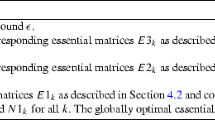Abstract
We present a novel approach for the estimation of 3D-motion directly from two images using the Radon transform. The feasibility of any camera motion is computed by integrating over all feature pairs that satisfy the epipolar constraint. This integration is equivalent to taking the inner product of a similarity function on feature pairs with a Dirac function embedding the epipolar constraint. The maxima in this five dimensional motion space will correspond to compatible rigid motions. The main novelty is in the realization that the Radon transform is a filtering operator: If we assume that the similarity and Dirac functions are defined on spheres and the epipolar constraint is a group action of rotations on spheres, then the Radon transform is a correlation integral. We propose a new algorithm to compute this integral from the spherical Fourier transform of the similarity and Dirac functions. Generating the similarity function now becomes a preprocessing step which reduces the complexity of the Radon computation by a factor equal to the number of feature pairs processed. The strength of the algorithm is in avoiding a commitment to correspondences, thus being robust to erroneous feature detection, outliers, and multiple motions.
Similar content being viewed by others
References
Antone, M. and Teller, S. 2002. Scalable, extrinsic calibration of omni-directional image networks. International Journal of Computer Vision, 49:143–174.
Arfken, G. and Weber, H. 1966. Mathematical Methods for Physicists. Academic Press.
Basri, R. and Jacobs, D.W. 2003. Lambertian reflectance and linear subspaces. IEEE Trans. Pattern Anal. Mach. Intell., 25(2):218–233.
Chirikjian, G. and Kyatkin, A. 2000. Engineering Applications of Noncommutative Harmonic Analysis: With Emphasis on Rotation and Motion Groups. CRC Press.
Daniilidis, K. and Spetsakis, M. 1996. Understanding noise sensitivity in structure from motion. In Visual Navigation, Y. Aloimonos (Ed.). Lawrence Erlbaum Associates: Hillsdale, NJ, pp. 61–88.
Deans, S. 1981. Hough transform from the radon transform. IEEE Trans. Pattern Analysis and Machine Intelligence, 3:185–188.
Dellaert, F., Seitz, S., Thorpe, C., and Thrun, S. 2000. Structure from motion without correspondence. In CVPR. Hilton Head Island, SC.
Driscoll, J. and Healy, D. 1994. Computing fourier transforms and convolutions on the 2-sphere. Advances in Applied Mathematics, 15:202–250.
Fermuller, C. and Aloimonos, J. 1995. Direct perception of three-dimensional motion from patterns of visual motion. Science, 270:1973–1976.
Gallier, J. 2005. Notes on group actions, manifolds, lie groups, and lie algebras. http://www.cis.upenn.edu/~cis610/lie1.pdf/.
Geyer, C. and Daniilidis, K. 2001. Catadioptric projective geometry. International Journal of Computer Vision, 43:223–243.
Geyer, C., Sastry, S., and Bajcsy, R. 2004. Euclid meets fourier. In Workshop on Omnidirectional Vision. Prague.
Helgason, S. 2000. Groups and Geometric Analysis: Integral Geometry, Invariant Differential Operators, and Spherical Functions. American Mathematical Society.
Horn, B. and Weldon, E. 1988. Direct methods for recovering motion. International Journal of Computer Vision, 2:51–76.
Jin, H., Favaro, P., and Soatto, S. 2003. A semi-direct approach to structure from motion. The Visual Computer, 19:1–18.
D.H. Jr., Rockmore, D., Kostelec, P., and Moore, S. 2003. FFTs for the 2-sphere—improvements and variations. The Journal of Fourier Analysis and Applications, 9(4):341–385.
Kostelec, P.J. and Rockmore, D.N. 2003. FFTs on the rotation group. In Working Paper Series. Santa Fe Institute.
Lowe, D. 2004. Sift (scale invariant feature transform): Distinctive image features from scale-invariant keypoints. International Journal of Computer Vision, 60:91–110.
Mahajan, D., Ramamoorthi, R., and Curless, B. 2006. A theory of spherical harmonic identities for BRDF/lighting transfer and image consistency. In European Conference on Computer Vision, vol. IV, pp. 41–55.
Makadia, A., Geyer, C., Sastry, S., and Daniilidis, K. 2005. Radon-based structure from motion without correspondences. In IEEE Conf. Computer Vision and Pattern Recognition, San Diego.
Makadia, A., Sorgi, L., and Daniilidis, K. 2004. Rotation estimation from spherical images. In Proc. Int. Conf. on Pattern Recognition. Cambridge, UK.
Mariottini, G. and Prattichizzo, D. 2005. EGT: A toolbox for multiple view geometry and visual servoing. IEEE Robotics and Automation Magazine, 3(12).
Maslen, D. and Rockmore, D. 1995. Generalized FFTs—a survey of some recent results. In Proceedings of the DIMACS Workshop on Groups and Computation.
Nayar, S. 1997. Catadioptric omnidirectional camera. In IEEE Conf. Computer Vision and Pattern Recognition. Puerto Rico, pp. 482–488.
Negahdaripour, S. and Horn, B. 1987. Direct passive navigation. IEEE Trans. Pattern Analysis and Machine Intelligence, 9:168–176.
Oliensis, J. 2000. A critique of structure from motion algorithms. Computer Vision and Image Understanding, 80:172–214.
Roy, S. and Cox, I. 1996. Motion without structure. In Proc. Int. Conf. on Pattern Recognition. Vienna, Austria.
Schröder, P. and Sweldens, W. 1995. Spherical wavelets: Efficiently representing functions on the sphere. In SIGGRAPH ’95: Proceedings of the 22nd annual conference on Computer graphics and interactive techniques. ACM Press: New York. pp. 161–172.
Shi, J. and Malik, J. 1998. Motion segmentation and tracking using normalized cuts. In Proc. Int. Conf. on Computer Vision.
Sugiura, M. 1990. Unitary Representations and Harmonic Analysis: An Introduction. second edition. North Holland, Amsterdam.
Szeliski, R. and Kang, S.B. 1995. Direct methods for visual scene reconstruction. In IEEE Workshop on Representations of Visual Scenes, pp. 26–33.
Vidal, R. and Ma, Y. 2004. A unified algebraic approach to 2-D and 3-D motion segmentation. In European Conference on Computer Vision, pp. 1–15.
Wexler, Y., Fitzgibbon, A., and Zisserman, A. 2003. Learning epipolar geometry from image sequences. In IEEE Conf. Computer Vision and Pattern Recognition. Wisconsin.
Author information
Authors and Affiliations
Corresponding author
Additional information
The authors are grateful for support through the following grants: NSF-IIS-0083209, NSF-IIS-0121293, NSF-EIA-0324977, NSF-CNS-0423891, NSF-IIS-0431070, and ARO/MURI DAAD19-02-1-0383.
The author is grateful for the generous support of the ARO MURI program (DAAD-19-02-1-0383) while at U. C. Berkeley.
Rights and permissions
About this article
Cite this article
Makadia, A., Geyer, C. & Daniilidis, K. Correspondence-free Structure from Motion. Int J Comput Vis 75, 311–327 (2007). https://doi.org/10.1007/s11263-007-0035-2
Received:
Accepted:
Published:
Issue Date:
DOI: https://doi.org/10.1007/s11263-007-0035-2




